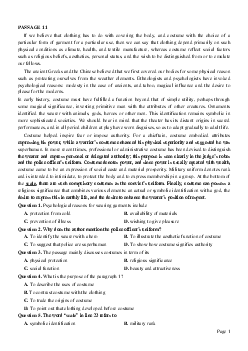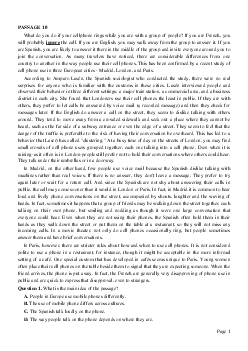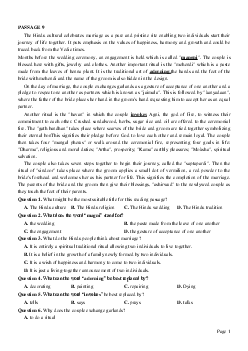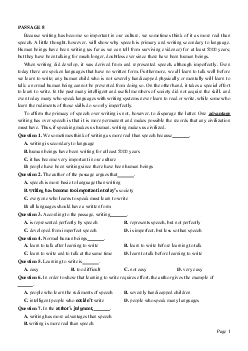

Preview text:
PASSAGE 30
In today’s fast-paced industry, learning will most likely involve seeking new skills in ways that
challenge the norm. But thankfully, there is promise for such lifelong learning online–a promise that will
save you time and money while helping you earn more of both.
Provided you have access to a decent computer and the Internet, the barrier to getting started is
probably lower than it ever has been. And with those things in place, it is a matter of finding the content
you wish to learn. So, to help others who may be looking to maximize their own learning efforts, I have listed some quick tips below.
First, set achievable goals. When you start learning, it is a good idea to set goals about what you want
to learn or what you might do with your newly acquired knowledge. It might be landing that new job,
building a tangible product, or impressing your current management. The goals may vary in size and
complexity, but do revisit these goals throughout your learning process. Within a couple weeks ask
yourself, “Am I getting closer to my goal?” or “Am I learning the skills necessary to reach my goals?” If
you are not, then you may need to look elsewhere.
Second, learn with others. By yourself, learning anything has a high propensity to become frustrating.
Try teaming up with friends or colleagues. They can often be your best resource for maintaining motivation while you learn.
Third, make it a habit. Online habits often include scrolling through social media or watching videos
on Youtube. If you have the downtime for such activities, then you could spend that downtime learning
something. And why not learn something? If you do, then you will have plenty more to talk about on
social media anyways. So, make learning your new online habit by making a commitment to learn something new each day.
Question 1. What does the word “both” in Paragraph 1 refer to? A. Time and money
B. Lifelong and online learning C. New skills and ways
D. Industry and technology
Question 2. According to the passage, what are the basic condition for online learning?
A. A smartphone and a 4-G sim card
B. A computer and the Internet
C. A goal and learning efforts
D. A content and the wish to learn
Question 3. According to the passage, what is the first step of learning online?
A. Buying a computer and having it checked every two weeks.
B. Landing a new job and building a tangible product.
C. Setting practical goals and checking them regularly.
D. Varying your goals in size as well as complexity.
Question 4. What is the word “commitment” in the last paragraph closest in meaning to? A. a rule B. a chance C. a need D. a situation
Question 5. What is the passage mainly about?
A. Tips for lifelong learning
B. Advantages of the Internet
C. Changes of technology
D. Effects of social media Page 1 ĐÁP ÁN 1-A 2-B 3-C 4-C 5-A
LỜI GIẢI CHI TIẾT Question 1: A
Từ "both" trong Đoạn 1 nói về điều gì?
A. Thời gian và tiền bạc
B. Học tập suốt đời và trực tuyến
C. Kỹ năng và cách thức mới
D. Công nghiệp và công nghệ
DẪN CHỨNG: But thankfully, there is promise for such lifelong learning online–a promise that will
save you time and money while helping you earn more of both.
DỊCH: Nhưng may mắn thay, có một lời hứa cho việc học trực tuyến trọn đời như vậy, một lời hứa sẽ
giúp bạn tiết kiệm thời gian và tiền bạc đồng thời giúp bạn kiếm được nhiều tiền hơn từ cả hai. Question 2: B
Theo đoạn văn, điều kiện cơ bản để học trực tuyến là gì?
A. Điện thoại thông minh và thẻ sim 4 G B. Máy tính và Internet
C. Mục tiêu và nỗ lực học tập
D. Một nội dung và mong muốn học hỏi
DẪN CHỨNG: Provided you have access to a decent computer and the Internet, the barrier to getting
started is probably lower than it ever has been.
DỊCH: Miễn là bạn có quyền truy cập vào một máy tính tốt và Internet, rào cản để bắt đầu có lẽ thấp hơn bao giờ hết. Question 3: C
Theo đoạn văn, bước đầu tiên của việc học trực tuyến là gì?
A. Mua một máy tính và kiểm tra hai tuần một lần.
B. Tiếp cận công việc mới và xây dựng một sản phẩm hữu hình
C. Đặt mục tiêu thực tế và kiểm tra chúng thường xuyên
D. Thay đổi mục tiêu của bạn về kích thước cũng như độ phức tạp.
DẪN CHỨNG: First, set achievable goals.
DỊCH: Đầu tiên, đặt mục tiêu có thể đạt được. Question 4: C
Từ “ commitment ’’thế nào trong đoạn cuối gần nhất có nghĩa là gì? A. một quy tắc B. một cơ hội C. một nhu cầu D. một tình huống
DẪN CHỨNG: So, make learning your new online habit by making a commitment to learn something new each day.
DỊCH: Vì vậy, hãy học thói quen trực tuyến mới của bạn bằng cách cam kết học một cái gì đó mới mỗi ngày. Question 5: A Ý chính của bài là gì?
A. Lời khuyên cho việc học tập suốt đời B. Ưu điểm của Internet C. Thay đổi công nghệ
D. Ảnh hưởng của truyền thông xã hội Page 2




